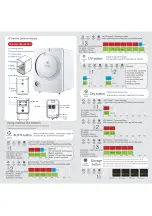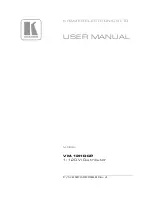
13
14
1. Ensure that the area in which the machine will be stored is well-ventilated and free of any potential
fire hazards such as open flames, gas appliances, furnaces, water heaters, and other appliances.
2.Clean and lubricate machine prior to storage.
3.Lightly lubricate flails and rotor to inhibit rusting.
4.Touch-up any scratches or damaged area exposing metal to the elements.
5. Order and re-apply any safety labels. Refer to "Information on Safety Decals" in" Parts
Breakdown Section" of the manual for placement and parts numbers.
6.Verify with engine manufacturer's handbook for guidance on preparing engine for storage.
7.Store unit in transport position (see "Transporting the SCARIFIER " in "Operation Procedures"
section).
8.Store the machine in a covered or indoor storage area for increased protection and longevity.
This section encompasses two general types of maintenance:
1. Preventative Maintenance and 2. General Service. The first refers to regularly scheduled
routine care of the scarifie r, such as cleaning and lubrication. The second provides information
on common procedures, such as changing flails, and adjusting the drive belt that are to be
performed as needed.
By f ollowing the Insp ect ion Schedule below BEFORE and AFTER each use of the scarif ie r,
appropriate actions can be taken to extend the service life of the machine and reduce any costly repairs
and unnecessary downtime for the unit.
A. Inspection Schedule
The following list aims to offer some basic guidelines to performing a detailed inspection BEFORE and
AFTER each use. Certain checks will require some disassembly, i.e. the removal of the drive guard, to
perform. Depending on various environ-mental conditions and frequency of use, other inspection points may
have to be added for each machine.
B. Preventative Maintenance Procedures
Maintaining a regular cleaning and lubrication schedule as well as taking time to perform preventative
maintenance procedures, will prolong the service life of the SCARIFIER. The following are guidelines to
setting up a regular maintenance routine for the scarifier.
1. Cleaning the SCARIFIER
i. After each use, the scarifier, in particular the flails and rotor assembly, should be cleaned and
washed of any dirt or debris that may be trapped in the unit.
ii. When using a power pressure washer to clean the unit, DO NOT USE ANY MACHINE RATED
HIGHER THAN 1000 PSI.
iii. Beware of damaging any warning decals and labels, as well as the drive belt, bearings and engine.
Limit direct spray on these objects to help prevent their wear and tear.
iv. For easier access to cleaning the scarifier, the machine may be tipped on its engine guard for
NO MORE THAN 2 MINUTES. Engine damage may result from petrol flowing into the crankshaft
due to prolonged tipping.
2. Lubrication Schedule
Regularly scheduled lubrication of the wheels, flails & rotor assembly, and linkage joints in the carriage is
essential to smooth performance and extended equipment life. The following schedule is a recommended
guide to lubricating your SCARIFIER. The schedule should be adjusted for various environmental conditions
and frequency of use.
Item
Yes
No
Is the engine oil filled to recommended levels? Consult Engine Manufacturer's Manual.
Is the engine air cleaner properly attached and clean? Consult Engine Manufacturer's
Manual.
Is the clutch cable properly attached? Refer to p.10 "Setting up the Scarifier" for details.
Is the clutch cable worn or visibly damaged? Replace if necessary.
Is the drive belt tension set properly? Refer to p.16 "Replacing Drive V-Belt and Pulley" for
details.
Does the drive belt show signs of wear and tear? Replace if necessary.
Are all the flails in good condition? Are any flails worn down to minimum length of 3"/
7.6 cm? If so, have they been replaced?
Are the spring clips which secure the flails and rotor shaft in good condition? If so, make
sure that the sprockets will be replaced before any further use as worn sprocket can lead to
chain slippage and other mechanical issues that may cause serious harm to the jobsite
and/or bodily damage to the operator.
Is the carriage securely fastened and free of all debris? Lingering debris may lead to
premature wear on the machine and shorten performance life.
Are the safety warning labels and other decals clearly identifiable and legible? If not, ensure
that fresh decals will be re-applied prior to use for operator safety.
Is the frame and handle in good condition with no visible damage or rusting? If not, contact
your local authorised dealer to replace parts prior to further use.
All service should be performed by trained technicians.
STORING THE SCARIFIER
MAINTENANCE PROCEDURESCONT'D...
MAINTENANCE PROCEDURES
Technician should read and thoroughly understand all manuals pertaining
to the machine to be serviced. Do NOT proceed with any service and
maintenance activity until ALL questions and concerns have been addressed.
Please contact your local authorised dealer for technical support and advice.
ALWAYS consult and verify that all local codes and bylaws are followed
before performing any service or maintenance procedures.
Item
Suggested
Lubricant
Every 20
hours
Every 60
hours
As
required
After each
pressure wash
Storage
Engine
Refer to Owner's
Manual for Engine
Depth Adjustment
Lever
General Purpose
Spray Lubricant
Wheels
Lithium-based Grease
Folding Handle
Attachment Kits
General Purpose
Spray Lubricant
Flails & Rotor
General Purpose
Spray Lubricant
Linkage
General Purpose
Spray Lubricant
Grease
Nipple
General Purpose
Spray Lubricant






























